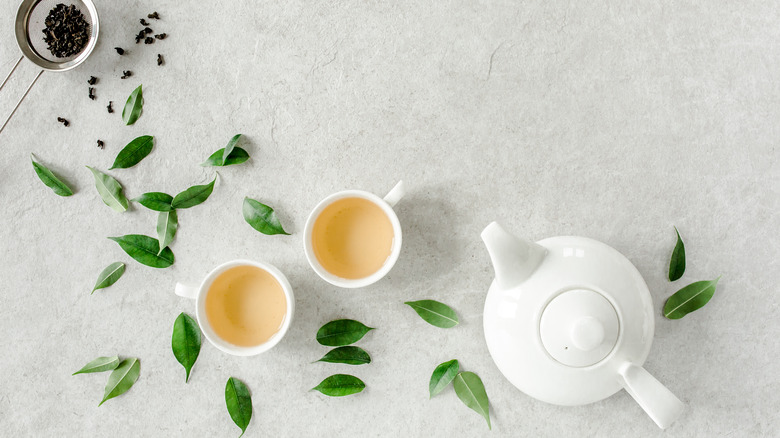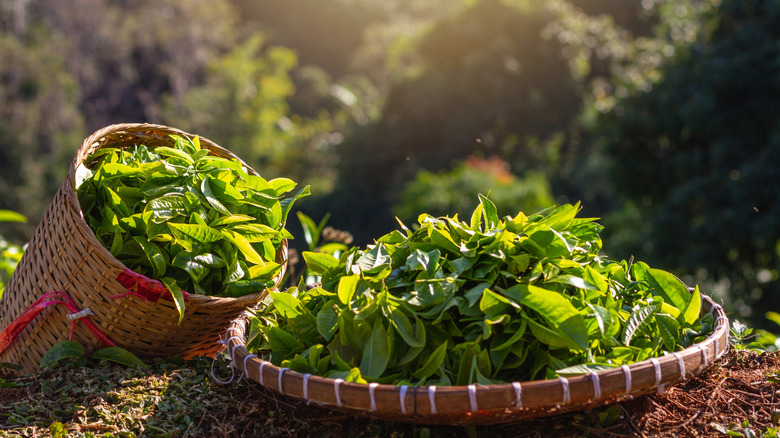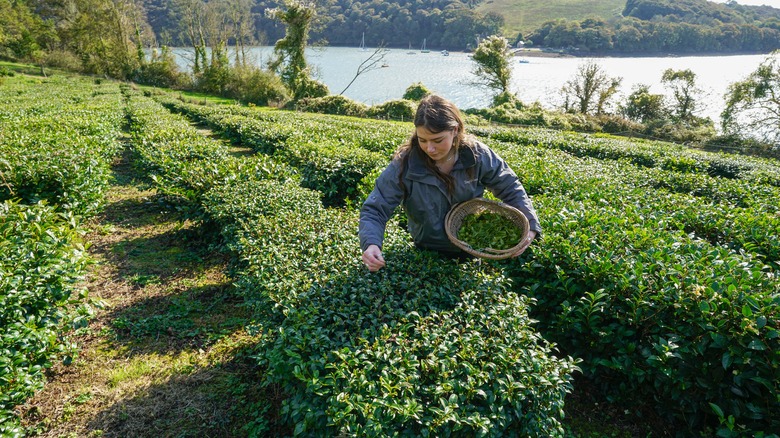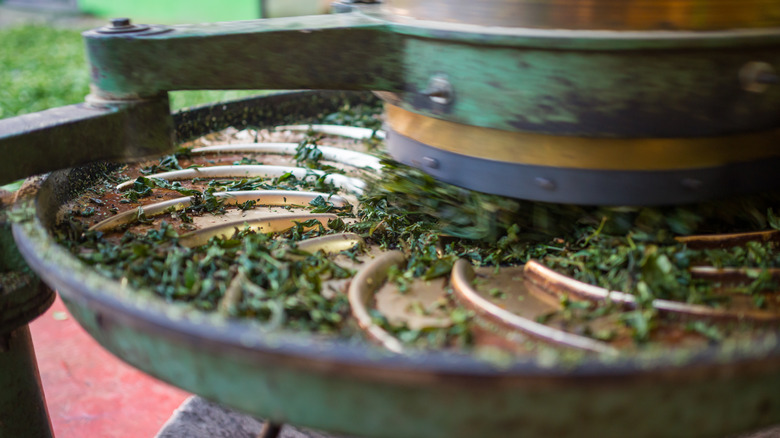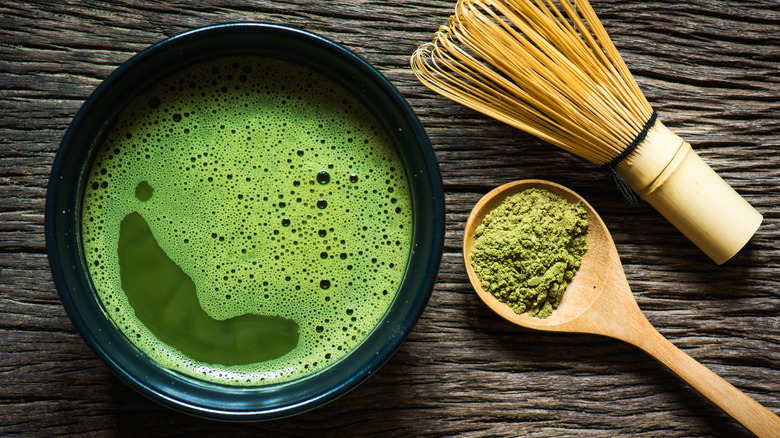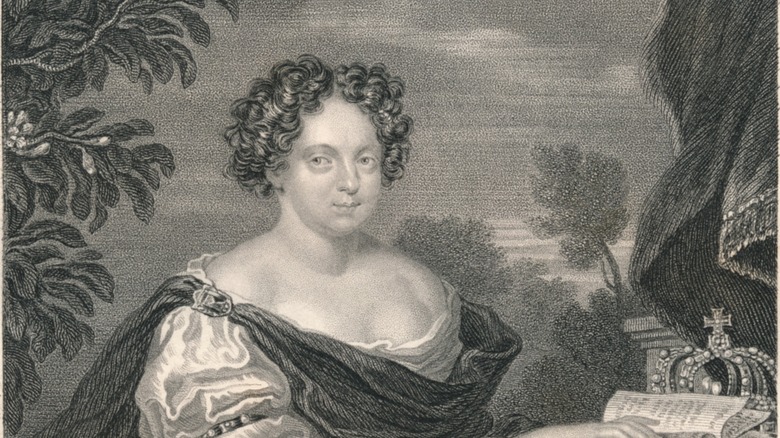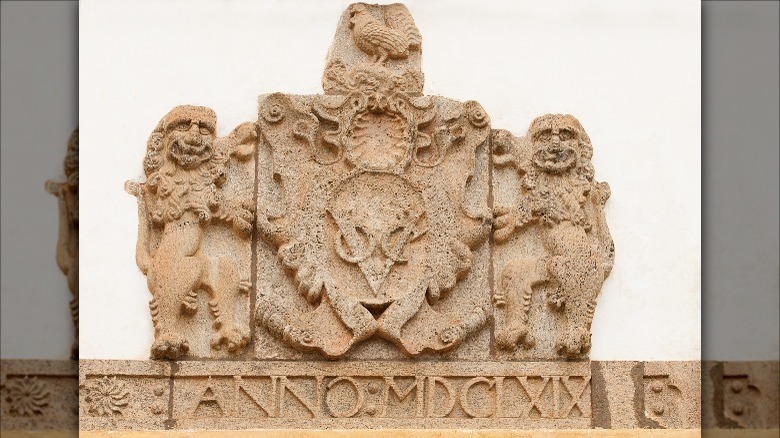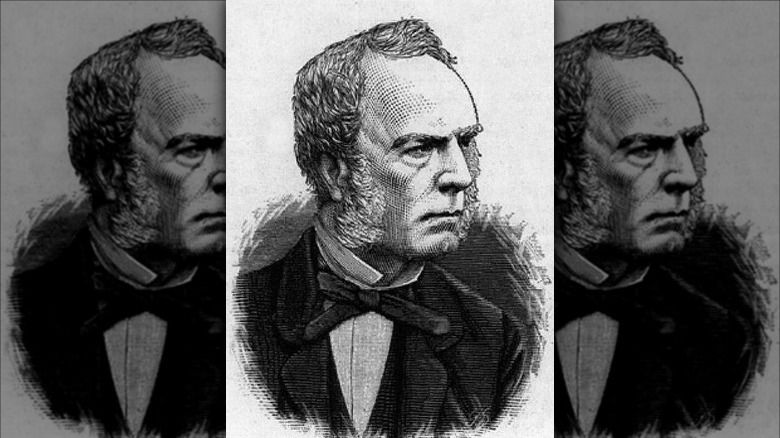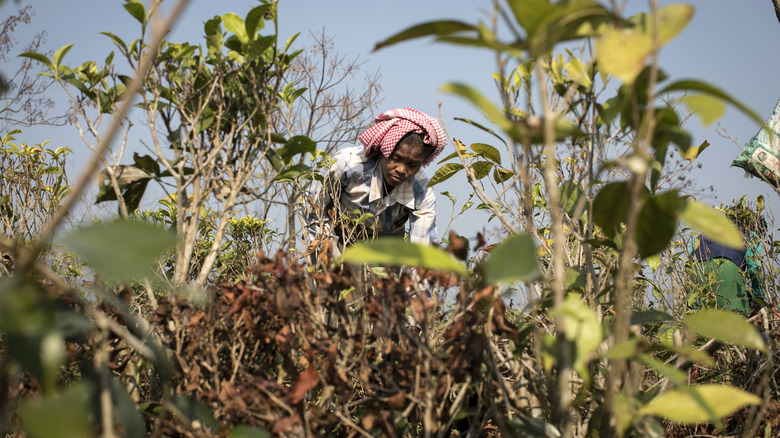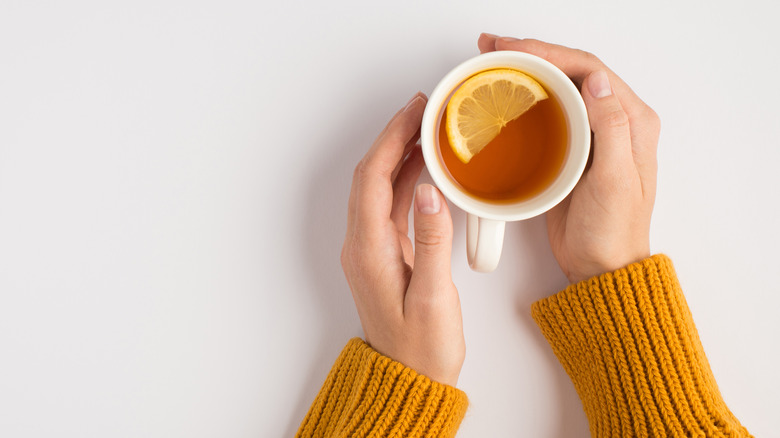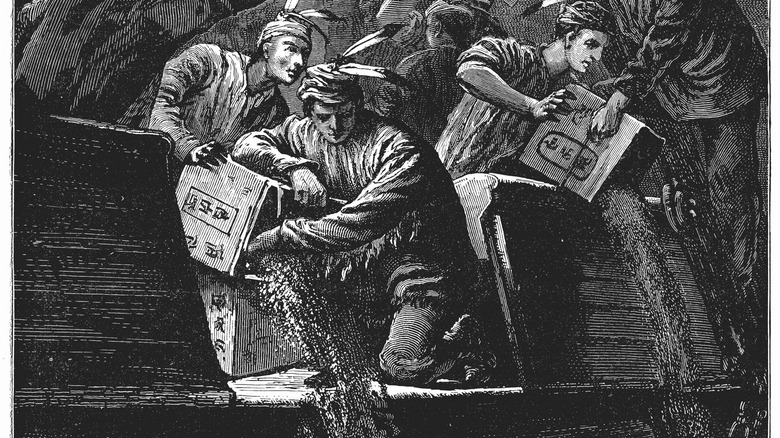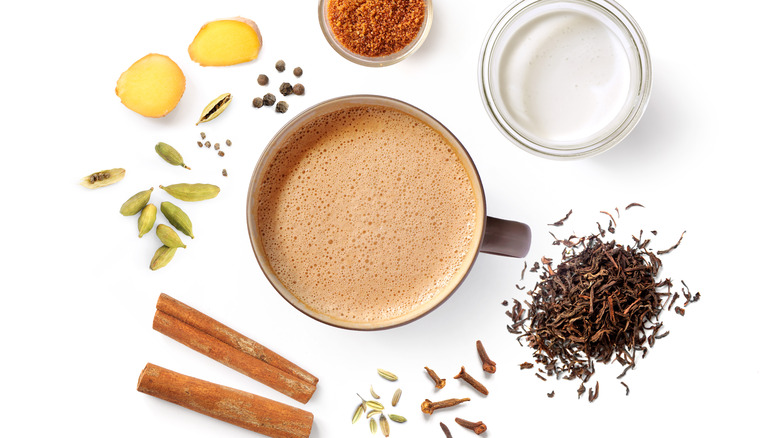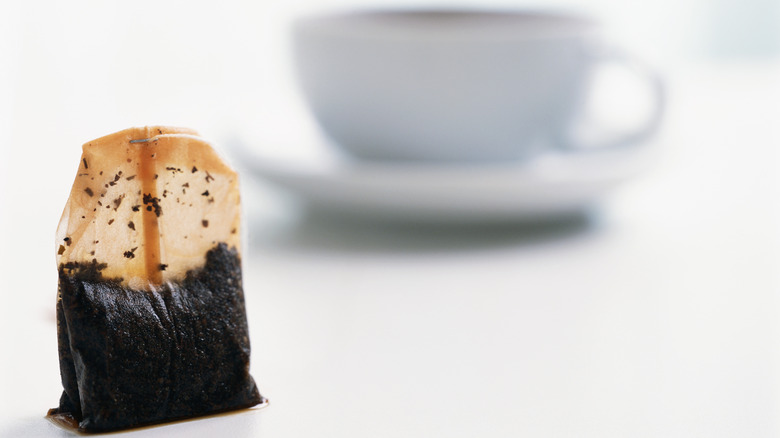The Ancient History Of Tea
Tea has a long and fascinating history. Over the years, it has spread from its origins in China to conquer the globe and become the most consumed drink, beating out competitors like coffee and beer (via National Geographic). Nature reports that, globally, over two billion cups of tea are consumed on a daily basis. It is no wonder the drink has become so popular. In addition to being a delicious beverage, it also comes with numerous health benefits. According to WebMD, tea is high in antioxidants, which can help fight heart disease and cancer. Tea also contains caffeine and theanine, which help keep you awake and alert.
When we say "tea," we are referring to the drink made from the plant Camellia sinensis (via the United Nations). As Harvard Health Publishing points out, herbal tea is not technically tea, since it does not contain leaves from the Camellia sinensis plant. However, tea is not homogenous. Tea can create a different array of flavors based on where it is grown, when it is harvested, and how it is processed (via Artful Tea). Green tea, for example, is made of the same leaves as black tea but is not permitted to oxidize during its processing to keep its green color.
How did this humble beverage capture the world and become the leading drink? We explored the history to track its spread across the globe.
The start in China
The exact location where Camellia sinensis first grew is unknown; however, the plant is thought to be native to what is now India, Myanmar, Thailand, Laos, Vietnam, and southwest China (via The United Nations and International Communication of Chinese Culture). However, China is popularly thought to be the drink's birthplace, and much of the history of the drink is centered around the country (via International Communications of Chinese Culture).
Evidence of tea in China has been found as far back as 5,000 years ago. One Chinese legend says that in 2732 B.C., Emperor Shen Nung was boiling a pot of water when leaves from a tree blew into the pot. The emperor drank the infused liquid and was entranced by the smell, taste, and refreshing feeling the drink brought to him (via Coffee Tea Warehouse). He decided to name the drink ch'a.
The popularity of the drink only grew over time, as it was used for both medicinal purposes and as a recreational drink. China strictly controlled its production and used it as a main trade source.
Origin legends
There are other legends surrounding tea's origin. For example, in India, there is a legend that a man took a vow not to sleep for seven years (via Dethlefsen Balk). After five, though, he felt near to giving up, so he took some leaves from a nearby tree and ate them. They made him feel refreshed and got rid of his exhaustion, and he was able to keep his vow.
A similar tale from Japan says that one night, the person did indeed fall asleep. When he woke up, he was so enraged by his failure that he cut off his own eyelids. When the eyelids hit the ground, though, they became plants and grew. Eventually, it became a large, leafy bush. He used the leaves to make a drink and noticed its wonderful effects. People gathered from far and wide to see the tree for themselves and try the incredible drink.
Evolution of processing
After the discovery of tea, the processing of the leaves was rudimentary (via Teavivre). At first, tea was made simply by placing fresh leaves into boiling water and eating it with a spoon, similar to soup. In the Yunnan province in China, there is still a tradition of using ground tea leaves and adding spices to make a similar dish.
Thousands of years after tea was first discovered, tea processing began its major revolution with the start of making "tea cakes," or compressed bricks of leaves that allowed for storage. To do this, tea was rolled and packed. This created a strong-smelling tea, however. So between A.D. 618 and 1276, they began steaming the tea leaves before rolling them to get rid of the unpleasant odor. While the tea brick had some advantages, it was labor intensive and affected the quality of the tea. Soon, loose leaf tea, which skipped the packing step tea cakes went through, became popular. Between A.D. 960 and 1368, tea balls and loose leaf tea, along with a new set of quality standards, improved tea substantially.
The next step in the process was the abandonment of steaming and the introduction of roasting. Today, tea is made in much the same way. Once the leaves are picked, they are dried, often in the sun (via Eli Tea Bar). The leaves are then heated through steaming, roasting, or pan-frying; the leaves are then macerated and allowed to oxidize before a final drying when the leaves are ready.
The spread to other areas
For the most part, China controlled tea trade production throughout the world (via International Communications of Chinese Culture). However, there were other cultures outside of China that had tea.
In the ninth century, Japan was introduced to tea by people who traveled to China and returned with tea leaves (via Coffee Tea Warehouse). A Buddhist monk then returned to China with leaves and seeds. It is thought that Japan started growing tea at around that time. Over the centuries in Japan, not only did steeping the tea leaves take off as a popular drink, but grinding the green tea leaves into what we now call matcha also became popular (via Marukyu Koyamaen). This style of tea had been found in China previously but fell out of favor during the Mongol invasion. Japan was unique in that it produced its own tea. Other countries, such as Russia and Tibet, had to import tea from China.
Europeans began receiving tea shipments from China in 1610, after a Portuguese missionary returned home from China with tea and the Dutch East India Company began to trade and ship tea all over Europe (via Topic Tea).
Britain's introduction to tea
Britain got its first taste of tea in the 1600s (via the BBC). Dutch trading companies began to import tea all around Europe. At the time, it was still considered a luxury, not a daily drink, and could be purchased as a specialty item at coffee shops. It was not until 1662, though, that the British really got hooked on tea and changed the course of the plant forever.
In 1662, the soon-to-be Queen Catherine of Braganza, who was Portuguese, arrived to start her new life in Britain. When she got there, she asked for a cup of tea and found that even though trade with England existed, they did not have any tea for her. Luckily, though, when she and the king married a week later, tea was imported from Portugal.
Catherine's love of tea helped the drink grow in popularity among the wealthy and elite in Britain, and eventually, the East India Company began importing it directly to Britain. According to Topic Tea, within 50 years, tea managed to surpass coffee in British coffee houses as the most popular beverage.
Chinese control and the East India Trade Company
Outside of China, the Dutch controlled the trade of tea within Europe (via Coffee Tea Warehouse). That was, however, until Britain got a taste for tea. The British monarchy wanted more tea and gave the East India Company so much power that they became the most prominent traders in Europe and Asia. Soon tea was one of their biggest commodities.
There was just one problem: All the tea for trade was still grown in China, which meant China had complete control of trade. Tea was a significant export for China, along with porcelain and silk, but the Chinese government did not want any British products in return (via the National Army Museum). Instead, they wanted payment for their goods in silver. To retaliate, the East India Company smuggled opium into China in the 1800s, sold it for silver, and used that silver to pay for tea and other goods. The Chinese government was not happy about the rise in opium use and began to crack down on opium imports. The bitter battle between the two sparked the Opium War.
The man who stole tea
The East India Company was not happy about the fact that China controlled all of the tea trade, so they decided to do something about it. The company decided they wanted to know everything there was to know about tea (via Undiscovered Scotland and Smithsonian Magazine). Their aim was to use this knowledge and establish their own tea production and to cut China out of the equation entirely. The only problem was China did not just hold all the tea for trade; they were the only ones who knew the secrets to processing it.
The company hired Scottish-born botanist Robert Fortune (via Undiscovered Scotland and Smithsonian Magazine). Fortune was tasked with going to China and stealing tea plants — and the secrets to processing their leaves — for the British.
Fortune ventured to China, dressed in disguise, and spent two years researching tea processing methods (via NPR). During that time, he toured factories, learning about the production of tea and taking diligent notes to report back to the East India Company. He also managed to gather samples of both live plants and seeds to transport.
Britain established tea in India
Through Robert Fortune's efforts, the British successfully stole the secrets of tea, and the ability to grow and produce it, from China. To find a suitable climate to grow the plants, they turned to India. Native tea plants had been found in Assam in the 1820s, so Indian cultivators could grow the plants, but they could not process them (via the BBC and Coffee Tea Warehouse). Seeing how well-suited parts of India were to the cultivation of tea, the East India Company set up shop. Because of Fortune and his wealth of knowledge and resources, they were able to establish their own plants in the 1830s. In the 1850s, the British planted tea in Darjeeling (via Cafe Richard).
Soon India was producing mass quantities of tea for British trade, an industry that took advantage of the Indian workforce to produce tea for their own benefit (via BBC). India went on to become the largest producer of tea in the world, and it took China more than 100 years to bounce back as a top producer (via NPR).
During his time in China, Fortune had also discovered that Chinese manufacturers were adding Prussian blue, which releases cyanide, and yellow gypsum to the tea they were shipping to England. They did this not to harm the British but because the British market wanted vibrantly green and uniform tea (via Smithsonian Magazine). However, both substances are poisonous, which bolstered the argument for East India Company tea over Chinese tea.
From luxury to necessity
Tea has gone through many phases, evolving from a luxury in many cultures to a daily drink.
A shift happened in India, as production grew and the country became the largest producer of tea in the world. Suddenly the supply of tea grew and could more easily keep up with the demand. This meant tea became affordable in India (via the BBC). Tea went from being a luxury item to one that was drunk commonly and could be afforded by those who were not necessarily rich.
In England, prior to the 18th century, tea was considered a luxury due in part to the outrageous 119% tax on the product (via the BBC). Such high taxes led to smuggling, which in turn created a big problem for the British government as they made no tax revenue on the smuggled tea. To counteract this, the tax was cut to 12.5% in 1783, leading to a rise in the availability and accessibility of tea to ordinary people. Britains were now drinking so much tea that despite the much lower tax rate, tax revenue increased during this period.
The Boston Tea Party
Britain was not just taxing the tea in their own land, but in their colonies as well. In the 1760s, Britain imposed a series of taxes on the American colonies, including a heavy tax on tea as a means of paying their excessive debts (via History). The colonists were not happy about this, mainly due to fact they were being taxed even though they had no representation in the British government. Britain got rid of all the extra taxes except the one on tea, but people were still unhappy. So they began smuggling in their own product from the Dutch and other sources.
Their act of financial rebellion initially worked, leaving the East India Company with a vast surplus and near bankruptcy. To counteract this and restore the East India Company's monopoly on the tea trade in the Americas, in 1773, the British government got rid of all tea-related import fees to allow the East India Company to sell tea cheaper than even smugglers, though the tea was still taxed.
Americans were not satisfied by this and saw through the British attempt to quell them. Three ships arrived on December 16, 1773, bringing goods from China, including tea. Thousands of colonists gathered to protest the import, but the governor ordered the tea tariff be paid. That night, men boarded the ships dressed as Native Americans and tossed 342 chests of tea overboard, totaling 90,000 pounds and valued today at almost $1,000,000. The event is known as the Boston Tea Party.
The evolution of chai
Chai has been around for more than 5,000 years (via Teatulia). Initially, chai did not contain the tea plant but was instead a mixture of herbs and spices made to have healing properties as part of the medical practice of Ayurveda. Spices could include ginger, pepper, cinnamon, cardamom, and star anise, each of which had its own medicinal properties. Blends for chai varied from region to region, with each producing its own unique mix (via Hackberry Tea).
When the British invaded and ruled India, they created a booming tea trade (via the BBC). This trade eventually led to Camellia sinensis tea becoming popular and affordable. However, the dark blends preferred by the British and grown in India could be quite bitter, so the British preferred their tea with milk and sugar. This way of making tea became popular in India.
"Masala chai," or "spiced chai," evolved from this practice to create a hot, spiced tea drink. The word "chai" itself means "tea," which is why the drink is referred to as masala or spiced chai, since "chai tea" literally translates to "tea tea."
The tea bag revolution
Perhaps the saying "the greatest thing since sliced bread" should really be "the greatest thing since tea bags." Tea was not sold in bags until relatively recently in its production. Yet, it is almost impossible for us to imagine tea without tea bags. While many scoff at the idea of tea bags, one cannot deny their popularity.
The tea bag first showed up in America at the turn of the 20th century (via Time). Around 1901, Milwaukee residents Roberta C. Lawson and Mary Molaren filed a patent for what they called a "tea leaf holder," which was remarkably similar to tea bags in use today. However, the most common story about the rise of the tea bag is that, in 1908, Thomas Sullivan was importing tea to America. He decided to send out samples of his product, individually packaged in silk pouches. Customers loved the ease of using them and asked for more. Tea bags steadily grew in popularity, and by 1952, big name tea brand Lipton introduced "flo-thru" tea bags.
Today, tea bags tend to be more easily accessible than loose leaf tea. As Artful Tea points out, though, tea bags tend to be filled with lower-quality tea that is more finely ground. But for the ease of preparation and wide availability, it is no wonder tea bags took off the way they did.
